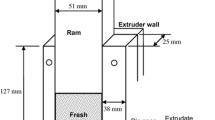Abstract
At present, the large amount of pollution generated by used tires in Ecuador is a very serious problem because 2,400,000 tires are discarded annually. A very high percentage of these used tires are those that end up on the banks of roads, vacant lots or water bodies, although it is true there have recycling plants, it is also true that a new way to reuse this material is needed. With regard to rubber, especially synthetic rubber, being this, the one used in the manufacture of tires has very interesting physical properties within the area of concrete manufacturing, such as elasticity, abrasion resistance, warm anti Softener, and sulfate resistance. The use of fibers due his properties helps to improve the adhesion and impact resistance of concrete, starting from this the article seeks to verify the usefulness of rubber as a fiber for the production of concrete, for this, a control mixture will carry out with a defined resistance, from which the amount of rubber fiber will vary depending on the coarse aggregate; The tests to be carried out will be the test of compressive strength, tensile strength, following the guidelines indicated in the INEN standards; taking into account that the results obtained must give an improvement or at least be equal to the resistance of the control specimen to guarantee its use.
Access this chapter
Tax calculation will be finalised at checkout
Purchases are for personal use only
Similar content being viewed by others
References
Salsilli, R.: Manual de diseño de pisos industriales. Primera. Instituto del Cemento y del Hormigon de Chile, Chile
SEGINUS. Disponible en: https://seginus.com.ec/. Consultado 22-ene-2020
Propiedades del Caucho. Vulcanización. – Química y algo más. Disponible en: https://quimicayalgomas.com/quimica-organica/hidrocarburos/propiedades-del-caucho-vulcanizacion/. Consultado 22-ene-2020
Yung, W.H., Yung, L.C., Hua, L.H.: A study of the durability properties of waste tire rubber applied to self-compacting concrete. Constr. Build. Mater. 41, 665–672 (2013). https://doi.org/10.1016/j.conbuildmat.2012.11.019
Richardson, A., Coventry, K., Edmondson, V., Dias, E.: Crumb rubber used in concrete to provide freeze–thaw protection (optimal particle size). J. Cleaner Prod. 112, 599–606 (2016). https://doi.org/10.1016/j.jclepro.2015.08.028
Guo, S., Dai, Q., Si, R., Sun, X., Lu, C.: Evaluation of properties and performance of rubber-modified concrete for recycling of waste scrap tire. J. Cleaner Prod. 148, 681–689 (2017). https://doi.org/10.1016/j.jclepro.2017.02.046
Gupta, T., Chaudhary, S., Sharma, R.K.: Mechanical and durability properties of waste rubber fiber concrete with and without silica fume. J. Cleaner Prod. 112, 702–711 (2016). https://doi.org/10.1016/j.jclepro.2015.07.081
ACI Committee 211: 211.1-91 Standard Practice for Selecting Proportions for Normal, Heavyweight, and Mass Concrete. Technical Documents, dic. 1991
ASTM: ASTM C39/C39M-18: Standard test method for compressive strength of cylindrical concrete specimens. ASTM International, West Conshohocken, PA. ASTM, AI (2018). ASTM C, vol. 192 (2018)
A. S. for Testing y Materials: ASTM C293, Standard Test Method for Flexural Strength of Concrete (Using Simple Beam with Center-Point Loading) (2001)
Author information
Authors and Affiliations
Corresponding author
Editor information
Editors and Affiliations
Rights and permissions
Copyright information
© 2020 The Editor(s) (if applicable) and The Author(s), under exclusive license to Springer Nature Switzerland AG
About this paper
Cite this paper
Moscoso, F., Romero, S.F.L., Serpa-Andrade, L. (2020). Use of Rubber Fibers to Prepare of Impact Resistant Concrete in Factory Slabs. In: Rebelo, F., Soares, M. (eds) Advances in Ergonomics in Design. AHFE 2020. Advances in Intelligent Systems and Computing, vol 1203. Springer, Cham. https://doi.org/10.1007/978-3-030-51038-1_5
Download citation
DOI: https://doi.org/10.1007/978-3-030-51038-1_5
Published:
Publisher Name: Springer, Cham
Print ISBN: 978-3-030-51037-4
Online ISBN: 978-3-030-51038-1
eBook Packages: EngineeringEngineering (R0)




